The orignal Lego marble machine
The Lego Marble Machine
It all started Christmas 1996, when my brother Markus pulled out the big box of Legos at home, and we started building various little machines again. Markus posed the problem of building a 'marble pump', which would elevate marbles by adding marbles to the bottom of a column of marbles, and push them up.
This was a cool problem, and we both immediately set out to develop such a machine out of Legos. I built one that was exceedingly simple but didn't run very smoothly, and Markus built one that ran very elegantly, but required five 40-tooth gears, and various connecting rods and sliders. The machine was cool to watch with all its moving parts, but not practical.
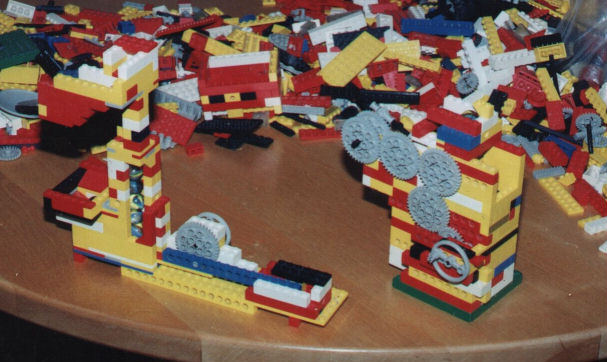
Early marble pump designs
The image above shows the first two marble machine pump prototypes. The machine on the left was my design. It basically had a cog that would raise the stack, and rely on another marble to roll down underneath the stack, then drop the stack onto the new marble. The big gear is the drive crank. It worked, but was very jerky.
The machine on the right is my brother Markus's design. Much more complicated - note all the gears. It was very tweaky, but when it worked, it ran very smoothly and quietly. The way it pumped marbles was just like subsequent marble pumps we built, but it was activated by two separate crankshafts, one for the slider motion, and one for the pistion motion.
|
A video showing both early types of marble pumps These experiments took place in 1996, way before digital cameras. But Markus recorded some of the experiments with a camcorder. |
|
Mid-evolution Once Markus combined the two motions of his machine onto one crank, it became a small and efficient building block that just asked for something to be built around it. The image to the right is a picture of the marble pump, with a tall ascent column for pushing the marbles on the left, and a clacky descent path on the right. The actual marble pump is on the bottom left, 6 x 8 Lego buttons, and about 7 full size Lego pieces high. The main crank to activate the slider and piston, as well as the slider and piston assembly are all internal to this unit. Markus is hand-cranking the machine. We had not yet motorised it at that point. Also, the ascent column is fully enclosed. I later made the marbles more visible by removing 1/4 of the column - leaving just enough Legos to contain the columns. Also, the machine only has a spiralling clacky descent, the top right part. Only one main path, no flipflop, and without removing unnecessary Legos for better marble visibility. Even in its early stage, it was a lot of fun. Had it not been, we would not have developed it further. |
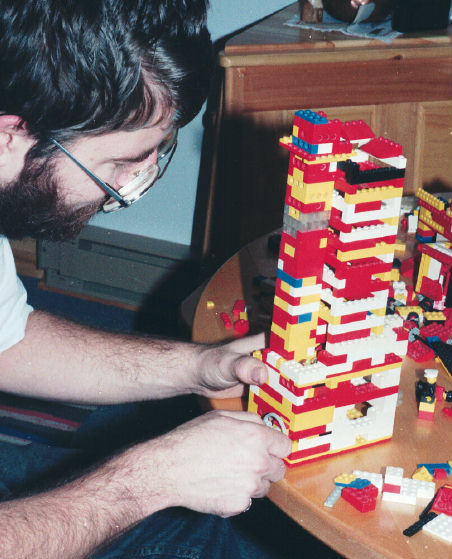
|
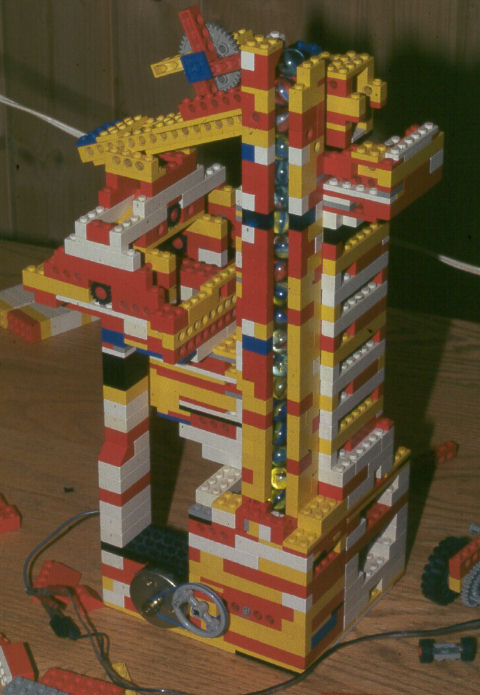 At the height of its glory
At the height of its gloryThe image on the left is the marble machine at the height of its evolution. I ended up adding more very complicated enhancements beyond this, but these somehow didn't help the aesthetic of the machine, and also made it more unreliable. I eventually removed the enhancements and put it back to its classic form as shown. In this state, it ran very reliably, making very nice noises, without jamming, breaking, and very rarely loosing a marble. On the front, you can see the partially exposed ascent column, where the marbles are pushed up by the pump. Imediately below this is the pumping unit, powered by a cassette deck motor and a rubber band pulley. Cassette deck motors are ideal for powering Lego machines - they are efficient, quiet, slow running, long lasting, and come with a pulley. They are best obtained by taking apart an old cassette player. At the top of the machine is the first flipflop, although you can't see much of it. It divides the marble stream into two, with half going down the clacking column behind the ascent column and the other half going to the left. The wheel with the 4 spokes on the top is just a gimmick, it gets turned by 1/4 turn by each marble that is deflected left into the three flipflop arrangement. The three flipflops divide the marbles into four separate paths. Each path ends up in a funnel that funnels them back into the marbles from the clacking descent column, and into the pump intake.
|
| This is another view of the machine. You can see a bit of the flipflops. Each flipflop uses one of those little 2x2 plates with a metal axle and wheels going through it (they don't sell those much now, but during the 70s those were more common). I use the wheel assembly as the pivot for the flipflop assemblies, with the wheels jammed into the flipflop's walls for mounting. If you scrutinize the image closely, you can see where the marbles roll. |
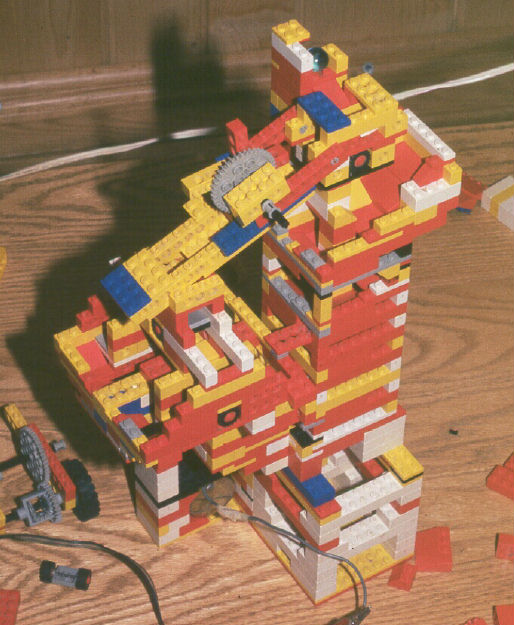
|
|
And another picture...
| ||
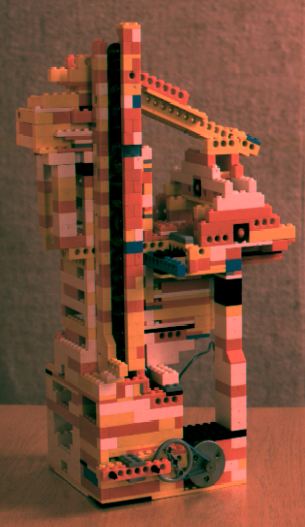
|
The picture at left I took with my scanner camera contraption.
Because taking pictures with the scanning camera was so much work, I also set the machine up nicely.
Markus had an old 8 mm camcorder at the time, and recorded the marble machine in various stages of its progress. I edited some clips of these together into a YouTube video.
|